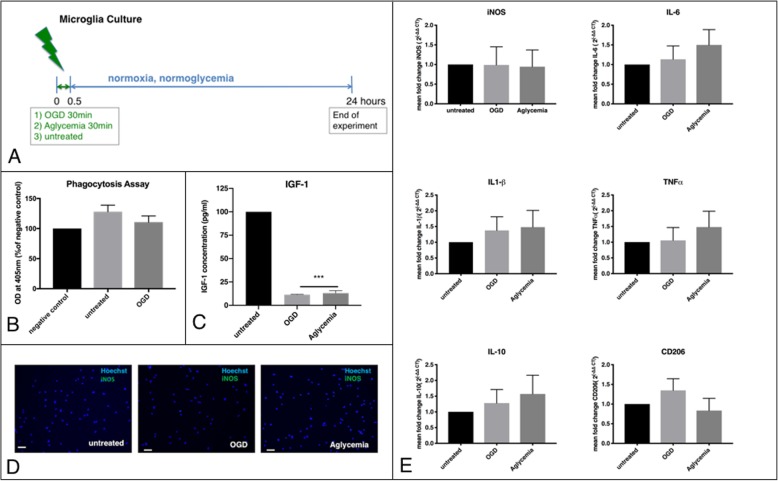Fig. 1.
Microglia dynamics after metabolic stress. a Experimental timeline. Microglia were exposed to metabolic stress by OGD or aglycemia for 30 min and then allowed to recover in regular culture medium for 24 h. Then the cells were used for further experiments. Unstressed microglia served as controls. b Microglia were incubated with phagocytic beads (zymosan) for 2 h, and zymosan uptake was quantified photometrically. Untreated cells without zymosan incubation served as the negative control. There was no significant effect of OGD on the phagocytic activity of microglia compared to unstressed control cells (values displayed as means ± SEM of three independent experiments with n = 6/each condition). c An IGF1-ELISA was used to quantify IGF1 release in the cell supernatant photometrically. Both OGD and aglycemia significantly reduced IGF1 release compared to unstressed controls (values are displayed as means ± SEM of three experiments with n = 12/each condition; the difference between treated groups: ***p < 0.0001 (one-way ANOVA/Tukey’s multiple comparison test). d Representative immunocytochemical images of iNOS+ cells (green), co-stained with a nuclear marker (Hoechst; blue). Staining did not reveal any iNOS+ cells in either unstressed microglia (left panel), microglia after OGD (middle panel), or microglia after aglycemia (right panel) (scale bars = 50 μm). e Q-PCR revealed that neither OGD nor aglycemia affected the expression of the M1 and M2 markers iNOS, TNFα, IL-6, IL-1β, IL-10, and CD 206 compared to unstressed microglia (values displayed as means ± SEM of three independent experiments with n = 12/ each condition, one-way ANOVA). Each Q-PCR sample was normalized to RPL13a as the reference gene, and mRNA levels were normalized to endogenous RPL13a expression

